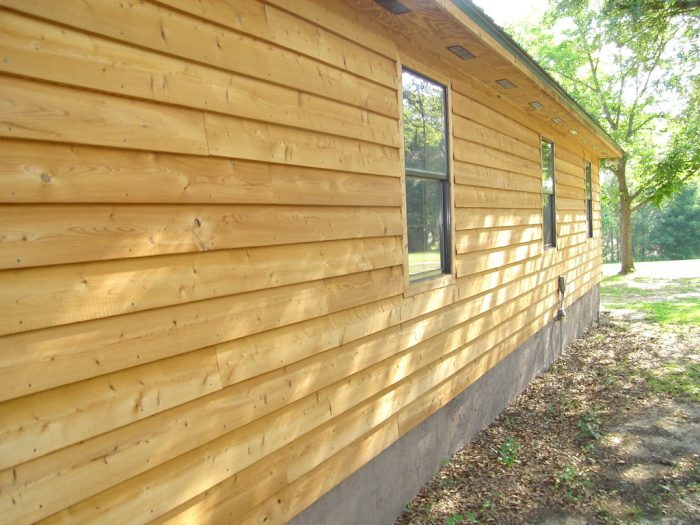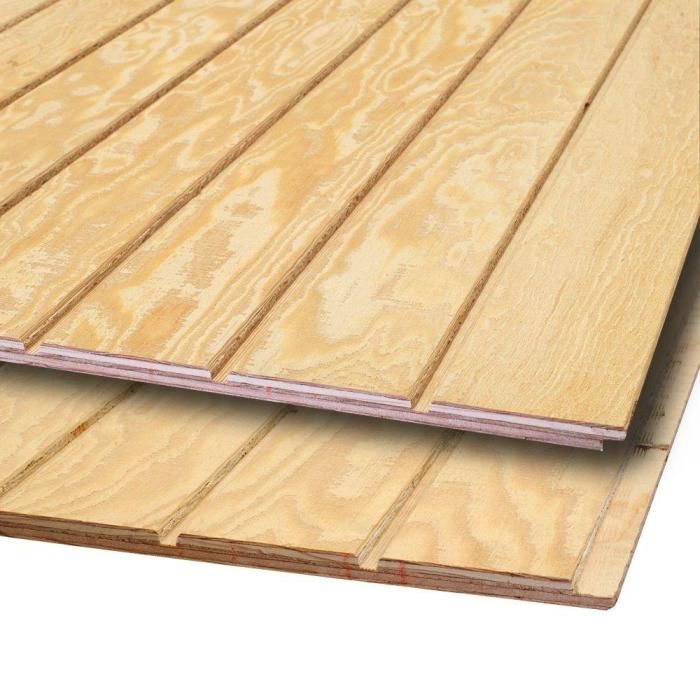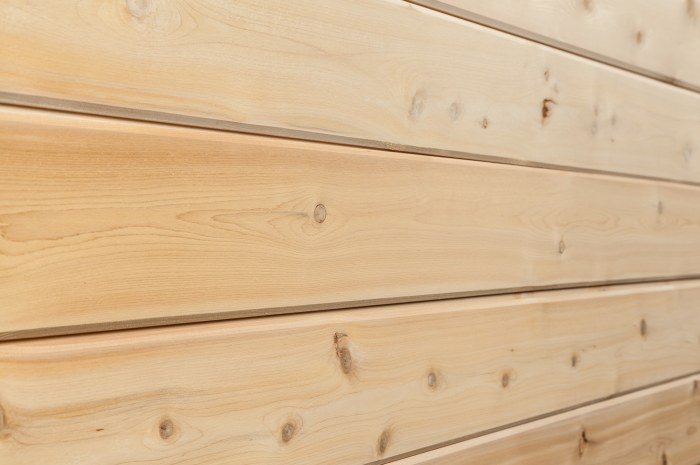Exploring the Beauty of Wood Plank Exterior Siding
Embark on a journey through the world of wood plank exterior siding, where tradition meets modernity in a harmonious blend of style and functionality. Learn about the timeless appeal and practical benefits of this versatile material that has adorned homes for generations.
Discover the artistry behind wood plank siding and how it can transform the look and feel of any property with its natural charm and durability.
Introduction to Wood Plank Exterior Siding

Wood plank exterior siding refers to the use of wooden planks to cover the exterior walls of a building. This type of siding provides a natural and timeless look to the structure, enhancing its aesthetic appeal.One of the key benefits of using wood plank siding is its durability and longevity.
When properly maintained, wood siding can last for decades, making it a cost-effective choice in the long run. Additionally, wood plank siding is versatile and can be painted or stained in various colors to suit different architectural styles.
Types of Wood Commonly Used for Exterior Siding
- Cedar: Cedar wood is a popular choice for exterior siding due to its natural resistance to decay and insects. It has a rich color and distinctive grain pattern, adding character to the building.
- Pine: Pine wood is another commonly used material for exterior siding. It is more affordable than cedar and offers a light, airy look when installed.
- Spruce: Spruce wood is lightweight and easy to work with, making it a popular choice for DIY projects. However, it may require more maintenance compared to cedar or pine.
Installation of Wood Plank Exterior Siding

Installing wood plank siding can enhance the aesthetic appeal of your home while also providing durability and protection from the elements. Proper installation is crucial to ensure longevity and efficiency.
Steps Involved in Installing Wood Plank Siding
- Prepare the surface: Ensure the exterior surface is clean, smooth, and free from any debris or old siding.
- Measure and cut: Accurately measure the dimensions of the walls and cut the wood planks to fit accordingly.
- Begin at the bottom: Start installing the siding from the bottom up, ensuring each plank is level and securely attached.
- Nail or screw: Use galvanized nails or screws to fasten the planks to the wall, leaving room for expansion and contraction.
- Overlap joints: Ensure proper overlap between planks to prevent water infiltration and maintain a seamless look.
- Finish with trim: Complete the installation by adding trim pieces around windows, doors, and corners for a polished look.
Tools and Materials Required for Installation
- Hammer or nail gun
- Saw for cutting
- Tape measure
- Level
- Galvanized nails or screws
- Wood planks
- Moisture barrier
- Insulation
Importance of Proper Insulation and Moisture Barriers
Proper insulation helps regulate indoor temperatures and energy efficiency, while moisture barriers prevent water damage and mold growth. These components are essential for maintaining the structural integrity of your home and ensuring a comfortable living environment.
Maintenance and Care for Wood Plank Exterior Siding

Regular maintenance is key to keeping your wood plank exterior siding looking great and lasting for years to come. By following some simple care tips, you can prevent mold, rot, and insect damage, as well as maintain the overall appearance of your siding.
Additionally, knowing how to properly refinish or repaint the siding when needed will help prolong its lifespan.
Tips for Regular Maintenance
- Regularly inspect the siding for any signs of damage, such as cracks, warping, or discoloration.
- Clean the siding at least once a year using a mild detergent and water to remove dirt, dust, and mildew.
- Trim any vegetation that is growing near the siding to prevent moisture build-up and potential damage.
- Apply a protective sealant or stain every few years to help protect the wood from the elements.
Preventing Mold, Rot, and Insect Damage
- Ensure proper ventilation around the siding to prevent moisture build-up, which can lead to mold and rot.
- Inspect the siding regularly for any signs of insect infestation, such as holes or sawdust, and take action immediately if detected.
- Keep the area around the siding clear of debris and standing water to discourage insects and rot-causing organisms.
Refinishing or Repainting Wood Plank Siding
- Before refinishing or repainting, clean the siding thoroughly and allow it to dry completely.
- Remove any old paint or finish using sandpaper or a paint stripper, if necessary.
- Apply a primer to the siding before painting to ensure better adhesion and longevity of the new finish.
- Choose a high-quality exterior paint or stain that is specifically formulated for wood surfaces and apply it according to the manufacturer's instructions.
Design and Style Options with Wood Plank Exterior Siding
Wood plank exterior siding offers a wide range of design and style options that can enhance the overall look of your home. Whether you prefer a modern or traditional aesthetic, wood plank siding can be incorporated seamlessly into various architectural styles.
Design Patterns and Styles
- Horizontal Planks: The most common style, horizontal wood plank siding creates a classic look that works well with both modern and traditional homes.
- Vertical Planks: Vertical siding can add a unique and contemporary touch to your home's exterior, making it stand out from the rest.
- Board and Batten: This style combines wide planks with narrow strips (battens) to create a rustic and charming look, perfect for cottages or farmhouse-style homes.
Color Choices and Finishes
- Natural Wood Finish: Letting the natural beauty of the wood shine through with a clear finish can give your home a warm and inviting appearance.
- Painted Finish: Opting for a painted finish allows you to customize the color of your siding to match your home's exterior color scheme.
- Weathered Look: Weathered wood plank siding can give your home a rustic and aged appearance, perfect for a cottage or beach house aesthetic.
Durability and Longevity of Wood Plank Exterior Siding
Wood plank exterior siding is known for its durability and longevity, making it a popular choice among homeowners. Let's delve into how wood plank siding compares to other materials in terms of durability, factors that can impact its longevity, and tips on extending its lifespan.
Comparing Durability with Other Siding Materials
Wood plank exterior siding is highly durable, especially when properly maintained. Compared to materials like vinyl or aluminum siding, wood plank siding can withstand impact better and is less prone to denting or cracking. However, it may require more upkeep to maintain its appearance and structural integrity over time.
Factors Affecting Longevity of Wood Plank Siding
Several factors can affect the longevity of wood plank exterior siding. Exposure to harsh weather conditions, such as heavy rain or intense sunlight, can cause the wood to deteriorate faster. Additionally, poor installation techniques or inadequate sealing can lead to moisture penetration, resulting in rot or mold growth that can compromise the siding's lifespan.
Extending the Lifespan of Wood Plank Siding
To extend the lifespan of wood plank exterior siding, regular maintenance is key. This includes inspecting the siding for any signs of damage, such as cracks or peeling paint, and addressing them promptly. Applying a fresh coat of sealant or paint every few years can also help protect the wood from moisture and UV rays.
Properly cleaning the siding and ensuring good ventilation around the exterior walls can prevent issues like mold or mildew growth.
End of Discussion
In conclusion, wood plank exterior siding offers more than just aesthetic appeal - it is a testament to craftsmanship and quality that stands the test of time. Embrace the warmth and character of wood plank siding to elevate your home's exterior with a touch of rustic elegance.
General Inquiries
How often should wood plank siding be refinished or repainted?
It is recommended to refinish or repaint wood plank siding every 3-5 years to maintain its appearance and protect it from the elements.
What are the common types of wood used for exterior siding?
Popular choices include cedar, pine, redwood, and spruce, each offering unique characteristics in terms of durability and aesthetics.
How can I prevent mold and rot on wood plank siding?
Regularly clean the siding, ensure proper drainage, and treat the wood with a protective finish to prevent moisture buildup and fungal growth.
Is wood plank siding more durable than vinyl siding?
While wood plank siding is known for its natural beauty, it requires more maintenance compared to vinyl siding, which is generally more resistant to rot and pests.




